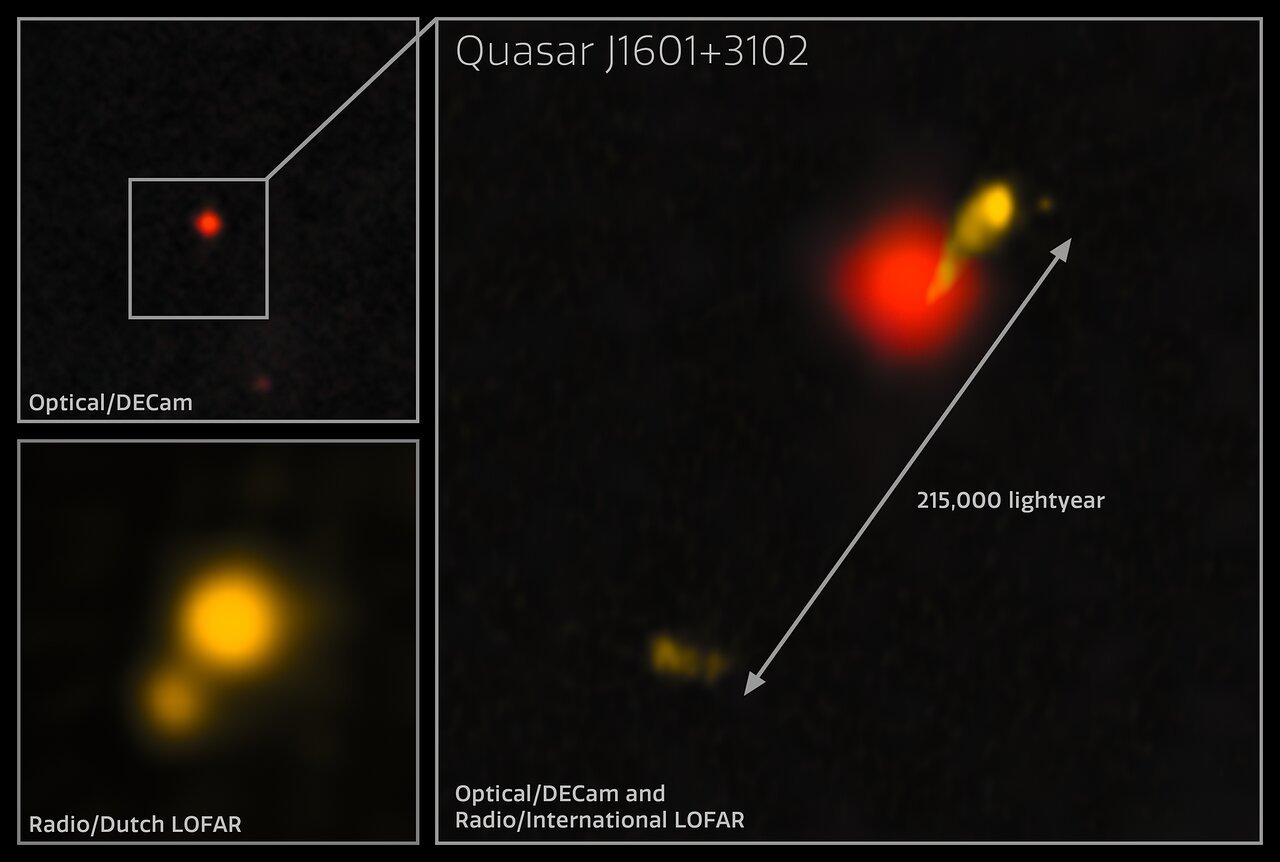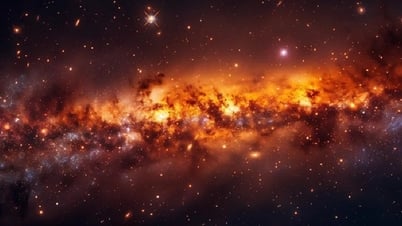(NLDO) - What scientists describe as a "radio jet monster" 215,000 light years long, comes from an extremely scary ancient object.
According to Sci-News , a "monster" radio beam coming from a quasar that is also a monster in the early universe has just been recorded simultaneously by many international observatories including the Low Frequency Array (LOFAR), the Gemini North telescope and the Hobby Eberly telescope.
Measuring 215,000 light-years long, it is the most powerful radio burst from the early universe ever to reach Earth's observatories.

The images that LOFAR recorded of the terrible radio rays and the quasar that emitted them, are both "monsters" in the universe - Photo: LOFAR NOIRLab
According to Dr. Anniek Gloudemans from the NOIRLab of the US National Science Foundation (NSF), the monster cosmic rays were discovered while they were using astronomical observation facilities to search for quasars emitting powerful jets in the early universe.
This is to help understand when these radio rays first appeared and their impact on the formation and early evolution of galaxies.
These jets also reflect properties of the quasar, such as its mass and rate of mass consumption, which are essential to understanding its formation history.
Quasars are black holes "disguised" as stars, due to their massive consumption of matter. They are often the nuclei of galaxies.
The record-breaking radio burst was found when they pointed it at J1601+3102, a quasar located in a region of space-time when the universe was just 1.2 billion years old.
That's more than 12.6 billion years ago, because our universe is now more than 13.8 billion years old.
Light takes time to reach Earth. So using telescopes to observe objects billions of light years away is capturing images of those objects in the past, when they were still pristine and had not yet been pushed too far away by the expansion of the universe.
While quasars we've recently observed can have masses billions of times larger than the Sun, this ancient quasar is quite small, weighing in at just 450 million times the mass of the Sun.
The radio rays emitted from the two sides of this quasar are asymmetric in both brightness and length, suggesting that they may be influenced by the harsh and significantly different environments on either side of the black hole's plane.
The paper, published in the scientific journal Astrophysical Journal Letters, concludes that in the early universe, giant radio jets could have been created without the need for very large black holes.
This evidence adds to a growing body of evidence suggesting that the early universe was wilder than we imagined, with powerful processes and "monster" objects behaving in ways that may no longer exist today.
Source: https://nld.com.vn/3-dai-thien-van-bat-duoc-tia-vo-tuyen-cuc-la-tu-quai-vat-126-ti-tuoi-196250208083740169.htm


![[Photo] Prime Minister Pham Minh Chinh launched a peak emulation campaign to achieve achievements in celebration of the 14th National Party Congress](https://vphoto.vietnam.vn/thumb/1200x675/vietnam/resource/IMAGE/2025/10/5/8869ec5cdbc740f58fbf2ae73f065076)
![[Photo] Prime Minister Pham Minh Chinh chairs the Government's online conference with localities](https://vphoto.vietnam.vn/thumb/1200x675/vietnam/resource/IMAGE/2025/10/5/264793cfb4404c63a701d235ff43e1bd)























































![[VIDEO] Summary of Petrovietnam's 50th Anniversary Ceremony](https://vphoto.vietnam.vn/thumb/402x226/vietnam/resource/IMAGE/2025/10/4/abe133bdb8114793a16d4fe3e5bd0f12)

![[VIDEO] GENERAL SECRETARY TO LAM AWARDS PETROVIETNAM 8 GOLDEN WORDS: "PIONEER - EXCELLENT - SUSTAINABLE - GLOBAL"](https://vphoto.vietnam.vn/thumb/402x226/vietnam/resource/IMAGE/2025/7/23/c2fdb48863e846cfa9fb8e6ea9cf44e7)





































Comment (0)